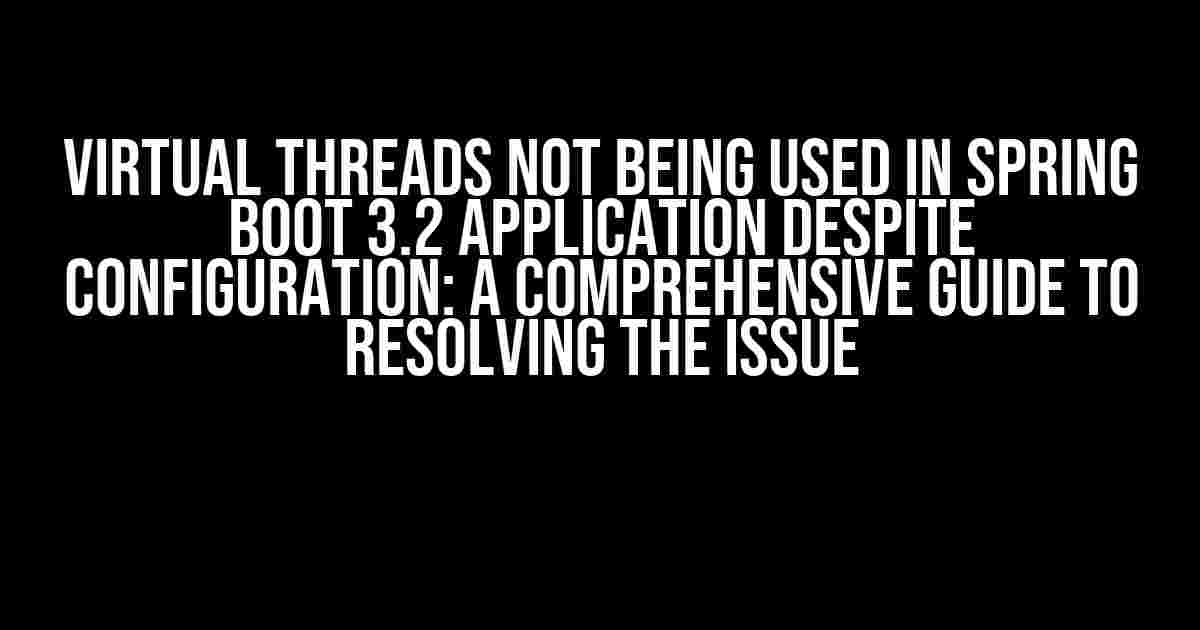Are you frustrated because you’ve configured your Spring Boot 3.2 application to use virtual threads, but they’re not being utilized despite your best efforts? You’re not alone! This article will walk you through the common pitfalls and provide clear, step-by-step instructions to get virtual threads working seamlessly in your application.
Understanding Virtual Threads in Spring Boot 3.2
VIRTUAL threads, a new concurrency model introduced in Java 19, allow you to write highly concurrent and scalable code with ease. Spring Boot 3.2, being the latest iteration of the popular framework, provides built-in support for virtual threads. However, without proper configuration and understanding, you might find yourself struggling to harness their power.
Why Are Virtual Threads Not Being Used?
Before we dive into the solutions, let’s identify some common reasons why virtual threads might not be working as expected:
- Insufficient configuration or incorrect setup
- Incompatible JDK version or dependency
- Incorrect usage of @Async annotation
- Conflicting dependencies or configurations
Configuring Virtual Threads in Spring Boot 3.2
To enable virtual threads in your Spring Boot 3.2 application, you need to follow these steps:
Step 1: Update Your Pom.xml (Maven) or build.gradle (Gradle)
Ensure you’re using the correct version of Java and the Spring Boot dependency:
<dependency>
<groupId>org.springframework.boot</groupId>
<artifactId>spring-boot-starter-webflux</artifactId>
</dependency>
<dependency>
<groupId>org.springframework.boot</groupId>
<artifactId>spring-boot-starter-reactor</artifactId>
</dependency>
<dependency>
<groupId>jakarta.enterprise</groupId>
<artifactId>jakarta.enterprise.language.model</artifactId>
</dependency>
Step 2: Configure the Application.properties File
Add the following configuration to your application.properties file:
spring:
reactor:
reactors:
- name: virtual-threads
type: virtual
Step 3: Create a Virtual Thread Bean
Create a new configuration class and define a bean for virtual threads:
@Configuration
public class VirtualThreadsConfig {
@Bean
public ReactorConfigurer reactorConfigurer() {
return reactor -> reactor.environment().put("reactor.schedulers.default", "virtual-threads");
}
}
Using @Async Annotation Correctly
The `@Async` annotation is used to mark methods that should be executed asynchronously. However, when using virtual threads, you need to ensure that you’re correctly configuring the executor:
@Service
public class MyService {
@Async("virtual-threads")
public CompletableFuture<Void> doSomeAsyncWork() {
// your asynchronous code here
return CompletableFuture.completedFuture(null);
}
}
Troubleshooting Common Issues
Still facing issues? Let’s troubleshoot some common problems:
| Issue | Solution |
|---|---|
| Virtual threads not being used despite configuration | Verify that the correct JDK version (Java 19 or higher) is used and that the configuration is correct |
| Conflicting dependencies or configurations | Examine your pom.xml or build.gradle file for conflicting dependencies and remove or update them as necessary |
| Incorrect usage of @Async annotation | Verify that the @Async annotation is used correctly, specifying the “virtual-threads” executor |
Conclusion
VIRTUAL threads can revolutionize the way you write concurrent code in your Spring Boot 3.2 application. By following the steps outlined in this article, you should be able to successfully configure and utilize virtual threads. Remember to troubleshoot common issues and adjust your configuration accordingly.
Don’t let virtual threads remain underutilized in your application – unlock their full potential and take your application to the next level!
Keywords: Virtual Threads, Spring Boot 3.2, Configuration, Troubleshooting, @Async Annotation, Reactor, Concurrency, Scalability, Java 19
Frequently Asked Question
Virtual threads, the latest feature in Java, seems too good to be true, but why aren’t they being used in my Spring Boot 3.2 application despite configuration?
Why do I need to configure virtual threads in my Spring Boot application?
By default, Spring Boot 3.2 doesn’t enable virtual threads. You need to add the `java.vendor` property and set it to `oracle` in your application.properties file to enable virtual threads. Additionally, you’ll need to add the `–enable-preview` flag when running your application to allow access to the virtual threads feature.
How do I enable virtual threads in my Spring Boot 3.2 application?
To enable virtual threads, add the following configuration to your application.properties file: `java.vendor=oracle` and `spring.aop.proxy-target-class=true`. Then, when running your application, add the flag `–enable-preview` to enable virtual threads.
What if I’m using an older version of Java?
Virtual threads are only available in Java 19 and later. If you’re using an older version of Java, you won’t be able to take advantage of virtual threads.
How can I verify that virtual threads are being used in my application?
You can use VisualVM or another profiling tool to inspect the threads in your application. Virtual threads will be identified as “virtual” in the thread list. Alternatively, you can log thread information within your application code to verify that virtual threads are being used.
What if I’ve configured everything correctly, but virtual threads are still not being used?
If you’ve configured everything correctly and virtual threads are still not being used, check the Spring Boot and Java version compatibility. Make sure you’re using compatible versions and that there are no conflicts with other dependencies in your project.

